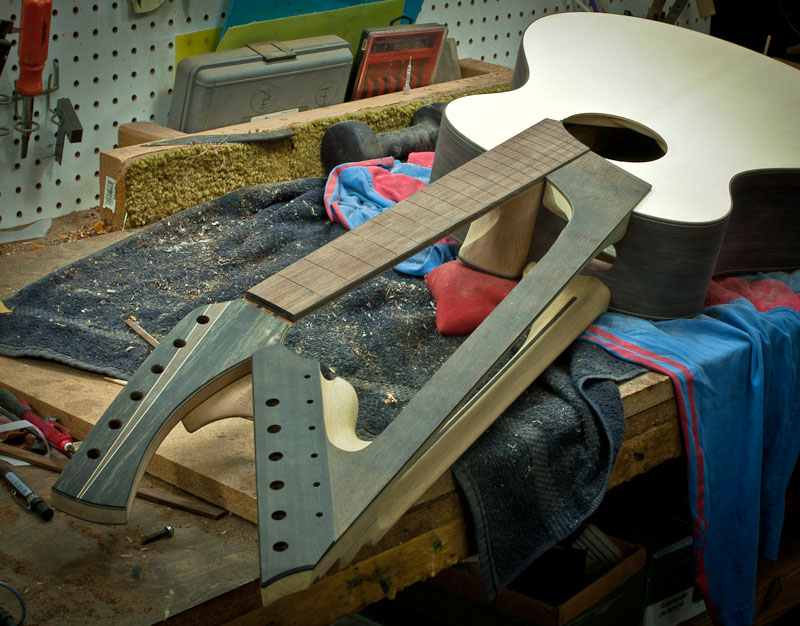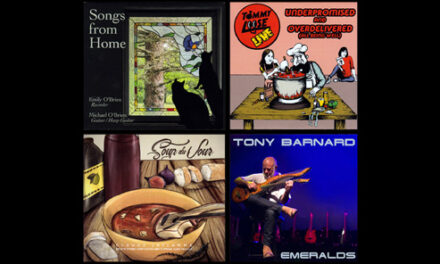The title just gives me an excuse to present two new discoveries; what I recognized that they have in common is the modern take (each for their time) on the design for sub-bass headstocks.
The first was built by Wilhelm Geittner about 1845 in what is now Wrozlaw, Silesia (Poland). It’s owned by renowned historical music player and guitar collector Brigitte Zaczek, a recent addition to her growing collection (but available for sale, she tells me…).
I just love the organic Stauffer-style double headstock, and of course the “retro” shoulder-sloping.

The second is the brand new, second harp guitar creation (commissioned by a Japanese guitar store) by the always-original Michi Matsuda.
Modern, indeed. I’m not exactly sure in which Gallery I’d place his new instrument. The harp head is sculpted onto a sort of dual-arm second neck.
Specs are: Italian spruce top, Indian rosewood sides and back, mahogany neck, Wenge fingerboard and bridge. The sub-bass ares are Catahua.
Here are a couple of in-process build photos Michi sent in:


Wild!
Thanks to both for these contributions to the site!







Amen to that, Jay!
As I tell everyone who is hoping to obtain a harp guitar but is unsure as to what type, come to a Harp Guitar Gathering to see the largest variety. I CANNOT STRESS THIS ENOUGH.
Newbies will also benefit from Frank’s article “Shopping for the Perfect Harp Guitar”: https://www.harpguitars.net/luthiers/shopping/harp_guitar_shopping.htm
Thanks Gregg for all the info which actually did answer my question brought on by my lack of exposure to a non-hollow arm harp guitar. It just seemed that by virtue of the structure the tonal aspects would be radically different. So much for my logic lol. When it comes to six strings I hope my tonal palate is somewhat educated but with harp guitars its been YouTube only. Hopefully that and my “wannabe” status are about to change soon.
Oh and I’m always grateful for the incredible diversity of taste, be it in musical instruments or a fine wine! What a boring world it would be without. 🙂
-jay
Jay, you’re asking a question that, like wine, could be debated and analyzed endlessly, with similar arbitrary and pretentious descriptive terms.
I won’t pretend that my wine palette or guitar ears are as sophisticated as others’, but in my experience (having probably had in my hands more vintage and modern harp guitars than any other person on the planet), hollow arm or no hollow arm is a non-issue. Meaning, irrelevant. Will it give the player a more resonant experience? Very likely, especially it you cuddle it like Stacy Hobbs. But there are a zillion factors that make up a harp guitar’s tone, and the hollow arm is no more consistent or predictable than many of those “magic” factors (caveat: excepting the better builders who really know what they’re doing). I’ve heard WAY more crappy than great hollow-arm Dyer knockoffs that can’t hold a candle to (for example) my double-neck Biehl. I’ve heard DYERS that aren’t as nice as the Biehl (but those are exceptions). Relating to what you may or may not be after: some Dyers/Dyer “copies” have church reverb subs, a few are dry as a doornail, many are in-between; some are pure fundamental, others have chromatic overtones that will drive you and your dogs nuts. Some produce insanely clear loud harmonics, some give an interesting chimey thud.
The main thing never to loose sight of is that it is all completely relative, and a matter of personal taste. Beauty is in the ear of the listener, and instruments sound “better” or “worse” depending on each individual (it’s rare that Benoit and I love the same instruments, for example).
As just one example, in 2009 (when I had them for sale: http://www.harpguitarmusic.com/listings/hg-ohg.htm ) I demo’d the tiny Brunner dbl-neck Outdoor Harp Guitars against my Dyer, and was stunned by the results (admittedly, the Brunner has a bit of a “magic” design, itself): http://www.harpguitarmusic.com/images/merch/ohg/ohg_demo.mp3 (use full-size speakers or pro headphones) – you’ll hear subs ring after stopped staccato neck chords, sub harmonics, etc. Near and far (from audience, not player’s, perspective).
It’s also fascinating (and even bizarre) how different players get completely different sounds out of the same instrument, but that’s a whole different topic.
I could go on and on, but I’m heading to the dining room to savor a nice Argentine Malbec with quarter notes of blackberry and cocoa, sympathetic undertones of cherry, nutmeg and Spam, and harmonic hints of velvety Velveeta cheese.
Music to my taste buds!
I should have stated that differently, I meant “sub-bass” strings. Were you referring to those when you said “harmonics”?
thanks,
-jay
To me I found the sound not so different with or without the hollow arm… Maybe less harmonics…
This brings up a question, as a result of my current “wannabe” harp guitar player status. Does a configuration like the Matsuda double neck resonate the bass strings any differently than say a hollow arm approach like a traditional Dyer?
Thanks!
-jay